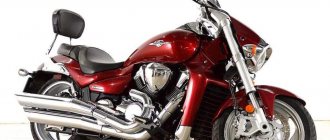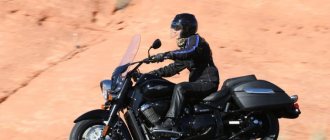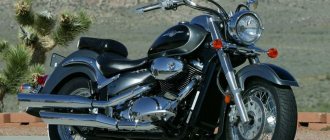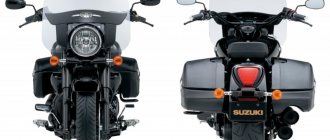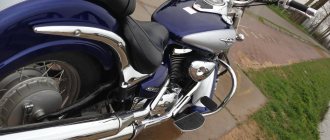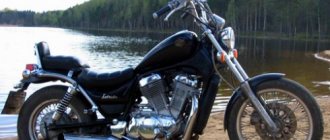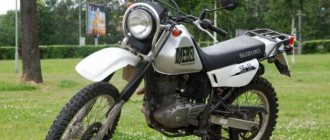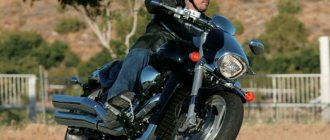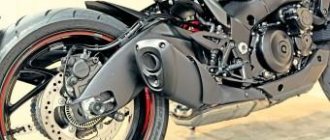| Suzuki VL800 Intruder Volusia (2001-2004) | Suzuki Intruder C800 / Boulevard C50 (2005+) | Suzuki Intruder C800C / Boulevard C50C (2006-2014) | Suzuki Boulevard C50T (2006+) |
Cruiser model Suzuki VL800 Intruder (Volusia)
appeared in 2001 as a classic modification of the Suzuki VS800 Intruder, produced in parallel with it until 2004 (in the American market in parallel with the Boulevard S50, until 2009).
The model was also available on the Japanese market under the name Suzuki Intruder 800 Classic
, sold there until 2006 inclusive.
Since 2005, the VL800 Volusia has been restyled and changed its name to Suzuki Boulevard C50
(for the American market) and
Suzuki Intruder C800
(for European and other markets). The main changes affected the appearance (new design of the air filter cover, rear light, headlight, etc.) and the technical part: the new model receives an injector and reduces the fuel tank capacity to 15.5 liters (instead of 17.0 liters).
Since 2006, two new modifications have appeared - Suzuki Boulevard C50C (Intruder C800C)
and
Suzuki Boulevard C50T
. The first version is distinguished by cast tubeless wheels, and the second - by a touring body kit (windshield, panniers, backrest, riveted saddle) and tires with white beads.
In 2009, the Suzuki Intruder C800 (Boulevard C50) model receives an injector with SDTV dual throttle bodies, and in 2021, the last year, it is produced for Europe. Currently, the model is available only on the American market in two modifications - Suzuki Boulevard C50 (spoke wheels) and Suzuki Boulevard C50T.
On the common basis of the Suzuki Intruder 800 Volusia and the Suzuki Intruder C800 (Boulevard C50), a version of the Suzuki Boulevard M50 (Intruder M800) was also created, which became the successor to the Suzuki VZ800 Desperado (Marauder).
In the domestic Japanese market, a 400 cc modification of the Suzuki VL800 Volusia and Suzuki Intruder C50 models was also offered - the Suzuki VL400 Intruder Classic, which was removed from the production line in 2021.
The main competitors of the Suzuki Intruder C800 (Boulevard C50) in the class:
- Honda VT750 Shadow
- Kawasaki VN800 Vulcan / Kawasaki VN900 Vulcan
- Yamaha Drag Star 1100 / Yamaha Midnight Star 950
Brief history of the model
- 2001 - start of production and sales of Suzuki VL800 Intruder Volusia.
Model:
Suzuki Intruder Volusia 800 (Europe, North America);
Suzuki Intruder 800 Classic (Japan). Factory designation:
VL800K1.
- 2002 - no significant changes.
Model:
Suzuki Intruder Volusia 800 (Europe, North America);
Suzuki Intruder 800 Classic (Japan). Factory designation:
VL800K2.
- 2003 - no significant changes.
Model:
Suzuki Intruder Volusia 800 (Europe, North America);
Suzuki Intruder 800 Classic (Japan). Factory designation:
VL800K3.
- 2004 - no significant changes.
Model:
Suzuki Intruder Volusia 800 (Europe, North America);
Suzuki Intruder 800 Classic (Japan). Factory designation:
VL800K4.
- 2005 - The Suzuki Intruder Volusia 800 model is replaced by the Suzuki Boulevard C50 for the American market and the Suzuki Intruder C800 for the European and other markets. On the Japanese market, the model has the same name - Suzuki Intruder 800 Classic.
Model:
Suzuki Boulevard C50 (North America);
Suzuki Intruder 800 Classic (Japan). Factory designation:
VL800K5.
- 2006 - model available on the European market. New modifications are appearing: touring and with alloy wheels. Last year of production for the Japanese market.
Model:
Suzuki Boulevard C50/C50C/C50T (North America);
Suzuki Intruder C800/C800C (Europe); Suzuki Intruder 800 Classic (Japan). Factory designation:
VL800K6, VL800UEK6, VL800CUEK6 (C800C), VL800CK6 (C50C), VL800TK6 (C50T).
- 2007 - no significant changes.
Model:
Suzuki Boulevard C50/C50C/C50T (North America);
Suzuki Intruder C800 / C800C (Europe). Factory designation:
VL800K7, VL800UEK7, VL800CUEK7 (C800C), VL800CK7 (C50C), VL800TK7 (C50T).
- 2008 - no significant changes.
Model:
Suzuki Boulevard C50/C50C/C50T (North America);
Suzuki Intruder C800 / C800C (Europe). Factory designation:
VL800K8, VL800UEK8, VL800CUEK8 (C800C), VL800CK8 (C50C), VL800TK8 (C50T).
- 2009 - the model receives an injector with dual throttle valves (SDTV - Suzuki Dual Throttle Valve).
Model:
Suzuki Boulevard C50/C50C/C50T (North America);
Suzuki Intruder C800 / C800C (Europe). Factory designation:
VL800K9, VL800UEK9, VL800CUEK9 (C800C), VL800CK9 (C50C), VL800TK9 (C50T).
- 2010 - no significant changes.
Model:
Suzuki Boulevard C50/C50C/C50T (North America);
Suzuki Intruder C800 / C800C (Europe). Factory designation:
VL800L0, VL800UEL0, VL800CUEL0 (C800C), VL800CL0 (C50C), VL800TL0 (C50T).
- 2011 - no significant changes.
Model:
Suzuki Boulevard C50/C50C/C50T (North America);
Suzuki Intruder C800 / C800C (Europe). Factory designation:
VL800L1, VL800UEL1, VL800CUEL1 (C800C), VL800CL1 (C50C), VL800TL1 (C50T).
- 2012 - no significant changes.
Model:
Suzuki Boulevard C50/C50C/C50T (North America);
Suzuki Intruder C800 / C800C (Europe). Factory designation:
VL800L2, VL800UEL2, VL800CUEL2 (C800C), VL800CL2 (C50C), VL800TL2 (C50T).
- 2013 - no significant changes.
Model:
Suzuki Boulevard C50/C50C/C50T (North America);
Suzuki Intruder C800 / C800C (Europe). Factory designation:
VL800L3, VL800UEL3, VL800CUEL3 (C800C), VL800CL3 (C50C), VL800TL3 (C50T).
- 2014 - no significant changes.
Model:
Suzuki Boulevard C50/C50C/C50T (North America);
Suzuki Intruder C800 / C800C (Europe). Factory designation:
VL800L4, VL800UEL4, VL800CUEL4 (C800C), VL800CL4 (C50C), VL800TL4 (C50T).
- 2015 - Alloy wheel version no longer available. The C800 is not being produced for the European market this year.
Model:
Suzuki Boulevard C50/C50T (North America).
Factory designation:
VL800L5, VL800TL5 (C50T).
- 2016 is the last year of production of the model for European countries.
Model:
Suzuki Boulevard C50/C50T (North America);
Suzuki Intruder C800 (Europe). Factory designation:
VL800L6, VL800TL6 (C50T); VL800UEL6.
- 2017 - no significant changes.
Model:
Suzuki Boulevard C50/C50T (North America).
Factory designation:
VL800L7, VL800TL7 (C50T).
- 2018 - no significant changes.
Model:
Suzuki Boulevard C50/C50T (North America).
Factory designation:
VL800L8, VL800TL8 (C50T).
- 2019 - no significant changes.
Model:
Suzuki Boulevard C50/C50T (North America, Australia).
Factory designation:
VL800L9 / VL800TL9.
- 2020 - no significant changes.
Model:
Suzuki Boulevard C50/C50T (North America, Australia).
Factory designation:
VL800M0 / VL800TM0.
- 2021 - no significant changes.
Model:
Suzuki Boulevard C50/C50T (North America, Australia).
Factory designation:
VL800M1 / VL800TM1.
Application
Interest in water recreation is growing more and more. Fans of fishing and hunting choose new, improved motors for moving across the waters.
Such engines include the Suzuki 50. This is a new generation four-stroke engine that runs quietly, starts smoothly and gives a quick start.
Small-sized and lightweight, it makes it possible to install it on small boats and boats, and lifting the motor and balancing it allows you to navigate through shallow water.
This motor is suitable for relaxing with family or friends, playing sports and diving, as well as for transporting people. They are used by rescuers and rangers, especially in remote areas where the distance between settlements is several tens of kilometers.
Photos
| Suzuki VL800 Intruder Volusia (2001-2004) | Suzuki VL800 Intruder Volusia (2001-2004) | Suzuki VL800 Intruder Volusia (2001-2004) |
| Suzuki Intruder C800 / Boulevard C50 (2005+) | Suzuki Intruder C800 / Boulevard C50 (2005+) | Suzuki Intruder C800 / Boulevard C50 BOSS |
| Suzuki Intruder C800C / Boulevard C50C (2006-2014) | Suzuki Intruder C800C / Boulevard C50C (2006-2014) | Suzuki Intruder C800C / Boulevard C50C (2006-2014) |
| Suzuki Boulevard C50T | Suzuki Boulevard C50T | Suzuki Boulevard C50T |
Specifications
Technical characteristics of Suzuki Intruder C800 / Boulevard C50:
| Model | Suzuki Intruder C800/Boulevard C50 |
| Motorcycle type | cruiser |
| Year of issue | 2001+ |
| Frame | steel tubular |
| engine's type | 2-cylinder, 4-stroke, V-shaped |
| Working volume | 805 cm³ |
| Bore/Stroke | 83.0 x 74.4 mm |
| Compression ratio | 9,4:1 |
| Cooling | liquid |
| Number of valves per cylinder | SOHC, 4 valves per cylinder |
| Fuel supply system | Carburetor, 2x Mikuni BDSR34 – Volusia Injector, 2x 34 mm – C800 / C50 (2005-2008) Injector (SDTV – Suzuki Dual Throttle Valve), 2x 34 mm – C800 / C50 (2009+) |
| Ignition type | transistor |
| Maximum power | 51.7 hp (38.0 kW) at 6000 rpm |
| Maximum torque | 69 Nm (6.9 kg*m) at 3500 rpm |
| Clutch | Multi-disc in oil bath, cable drive |
| Transmission | 5-speed |
| type of drive | cardan |
| Front tire size | 130/90-16 M/C 67H, tubed – Volusia, C800 / C50 / C50T 130/90-16 M/C 67H, tubeless – C800C / C50C |
| Rear tire size | 170/80-15M/C 77H, tubed – Volusia, C800 / C50 / C50T 170/80-15M/C 77H, tubeless – C800C / C50C |
| Front brakes | 1 disc, 300 mm, 2-piston caliper |
| Rear brakes | drum |
| Front suspension | 41 telescopic forks, 140 mm travel |
| Rear suspension | pendulum with monoshock absorber (7-step adjustable preload), stroke - 105 mm |
| Motorcycle length | 2510 mm |
| Motorcycle width | 985 mm - Volusia 970 mm - C800/C50/C50T |
| Motorcycle height | 1110 mm - Volusia 1105 mm - C800/C50 1397 mm – C50T |
| Wheelbase | 1650 mm - Volusia 1655 mm - C800/C50/C50T |
| Seat height | 700 mm |
| Minimum ground clearance | 140 mm |
| Gas tank capacity | 17.0 l (including reserve - 3.0 l) - Volusia 15.5 l (including reserve - 3.0 l) - C800 / C50 / C50T |
| Maximum speed | 177 km/h[1] |
| Acceleration 0-100 km/h (0-60 mph) | 6.22 sec[2] |
| Motorcycle weight (dry) | 239 kg – Volusia |
| Motorcycle weight (curb) | 267 kg - C800/C50 (2005-2008) 277 kg - C800/C50 (2009) 292 kg - C50T |
Run-in
Suzuki DF-50 is a very reliable outboard motor that has already been factory tested by qualified Suzuki operators. The engine is quite durable even in Russian conditions, but there are two main points, if observed, there will be no doubt about the reliability of the engine throughout its entire operation. Firstly, this is timely maintenance, and secondly, running-in, which is carried out at the first stage of using a boat motor, that is, immediately after purchase. The purpose of the run-in is to check the engine’s ability to withstand various loads in any climatic conditions. As part of the break-in, the engine operates over the entire speed range, which is very important for grinding in and adapting parts to the local climate.
Motors of similar power are tested exclusively in reservoirs with open space. This is one of the prerequisites, since running in a barrel is an ineffective option that can overheat the power plant. Running in a river or lake, on the contrary, allows you to reveal the full potential of the engine.
It is necessary to prepare properly for the break-in. In particular, it is very important to check the functionality of the cooling system. It has a special hole from which a stream of water usually comes out, in the form of a fountain. Thus, in the presence of this jet, overheating of the motor is eliminated to a minimum. In addition, before running in, you must properly arrange the motor in a vertical position, as described in the user manual. Next, you need to fill the gearbox with oil. For this, TCW-3 fluid with factory viscosity parameters is used. As for making the fuel mixture, this will require gasoline and oil in proportions of 50:1, respectively. A 10-hour break-in will require a large amount of fuel.
Most likely, the engine will smoke from a large amount of oil. Over time, this phenomenon will pass as the oil begins to burn.
Let's start running in
- Set the engine to idle, wait about half an hour
- Over each subsequent hour, we increase traction by about 10-15 percent. In eight hours the engine will reach 80% of its maximum performance
- Throughout the run-in, we switch to low, medium and high speeds, thus using the entire speed range. As stated above, variable load is extremely important for adapting parts to the environment
- At the end of the run-in, we drive up to the shore, set the idle speed, and wait until the engine cools down.
- After a few minutes, turn off the ignition and drain the spent fuel, then fill in new consumables. Run-in is complete.
Reviews
Reviews of Suzuki Intruder C800 (Boulevard C50):
Expand Collapse
Suzuki VL800 Volusia. Advantages.
1. Excellent torque of the engine, especially at low speeds.
2. The large weight allows the motorcycle to have excellent directional stability and not react to gusts of wind on the highway.
3. Suspension travel (front: 140 mm, rear: 104 mm) in combination with the weight of the device allows you to pass uneven sections of roads without any inconvenience for the driver. The passenger, of course, reacts to this all completely differently.
4. Excellent sound from stock mufflers.
5. Appearance (of course, this is all purely personal preference). Graceful fenders, long mufflers, beautifully shaped tank. My motorcycle has a two-tone paint job - metallic gray, which is applied at the factory in three layers, plus one layer of varnish.
6. Comfortable wide steering wheel and soft seat.
7. Large tank of 17 liters.
8. Convenient location of the footrests - not too far forward.
9. The wind deflector installed by the American provides excellent wind protection and allows you to ride without any problems with your helmet visor slightly open. The edge of the windshield goes just below my eye level.
Flaws. About them subjectively, from the girl’s point of view. And about some objective ones.
1. Weight. Not the heaviest, but I find it difficult to reverse on inclines.
2. Far away clutch handle. It can probably be adjusted, but with this setting I can barely reach it with all my fingers.
3. Long wheelbase, large turning radius.
4. Hot right side.
5. Small mirrors. And they are also highly adjustable. I tightened it once with the key and that's it. If during the process you realize that you need to change the angle a little, then that’s it – tighten it again with the wrench.
Suzuki VL800 Volusia. I had a motorcycle like this.
A good mid-size cruiser. Wide saddle, glove compartment for small tools on the key. For 2 years there was not a single breakdown. It drives well, confidently, in turns you can lean up to the footpegs . There were no comments on the cardan, oil did not leak from anywhere. Irregularities go over well, smoothly, you can adjust the rigidity. The wings and other elements such as side covers are made of plastic. And in appearance it is like a 1.5 liter. Indistinguishable (almost)
Wide saddle, glove compartment for small tools on the key. For 2 years there was not a single breakdown. It drives well, confidently, in turns you can lean up to the footpegs . There were no comments on the cardan, oil did not leak from anywhere. Irregularities go over well, smoothly, you can adjust the rigidity. The wings and other elements such as side covers are made of plastic. And in appearance it is like a 1.5 liter. Indistinguishable (almost)
I drove the C50 for a season, it’s definitely one of the best in its class... For 5000 km (3500 of them with a full load) nothing broke off or flew, it works like a clock... I rode the M50, I’ll say that the difference is so imperceptible... in fact there is almost none... In general, if you like it, then don’t doubt it, definitely VESCH Well, about the Sportster 883, I rode it a little, looked at the performance characteristics, in all respects it smokes on the side.....
in fact there is almost none... In general, if you like it, then don’t doubt it, definitely VESCH Well, about the Sportster 883, I rode it a little, looked at the performance characteristics, in all respects it smokes on the side.....
Appearance and Design
The classic design of the bike is emphasized by a moderate amount of chrome parts, as well as spoked wheels, fenders and a polished tank.
Within the city, the motorcycle behaves quite confidently, easily maneuvering between other road users. By the way, it is unlikely that you will be able to escape from the traffic jam – the large dimensions of the “Boulevard” will not allow you to do this.
The motorcycle reveals its potential on the track - here you can fully feel the power and determination of the unit. The motorcycle quickly picks up speed, changing gears quite easily and calmly. The Suzuki Boulevard easily accelerates to 160-170 kilometers, but this speed brings little pleasure due to the lack of a windshield.
The bike is lightweight, which has a beneficial effect on its maneuverability and controllability.
